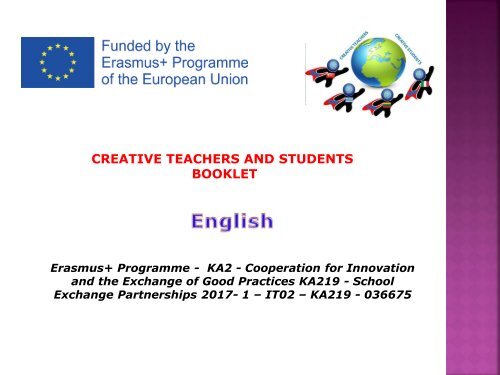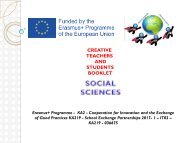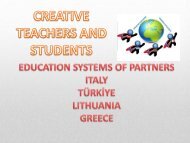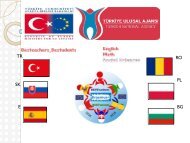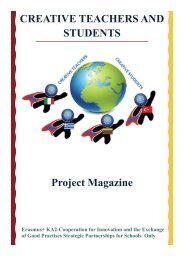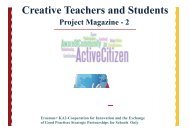english_booklet
You also want an ePaper? Increase the reach of your titles
YUMPU automatically turns print PDFs into web optimized ePapers that Google loves.
CREATIVE TEACHERS AND STUDENTS<br />
BOOKLET<br />
Erasmus+ Programme - KA2 - Cooperation for Innovation<br />
and the Exchange of Good Practices KA219 - School<br />
Exchange Partnerships 2017- 1 – IT02 – KA219 - 036675
The physical environment of school buildings and school<br />
grounds is a key factor in the overall health and safety<br />
of students, staff, and visitors. School buildings and<br />
grounds must be designed and maintained to be free of<br />
health and safety hazards, and to promote learning.<br />
Studies have shown that student achievement can be<br />
affected either positively or negatively by the school<br />
environment. Policies and protocols must be in place to<br />
ensure food protection, sanitation, safe water supply,<br />
healthy air quality, good lighting, safe playgrounds,<br />
violence prevention, and emergency response, among<br />
other issues that relate to the physical environment of<br />
schools.
Layout of room and furniture<br />
Adequate working space for students and<br />
teachers<br />
Ease of movement in the room<br />
Seating- facing board- neighbouring pupil<br />
compatibility- height for writing<br />
Appropriate resources/equipment organised<br />
and readily available for all pupils<br />
Good decor and lots of displays<br />
Temperture<br />
Noise level
Orderly rows (appropriate for large classes)<br />
Circle (for smaller classes)<br />
Solowork<br />
Horseshoe (for smaller classes)<br />
Separate tables (small groups at individual<br />
tables)
Whole class (the focus is on T and on the<br />
task)<br />
Group work (cooperative learning)<br />
Pair work (cooperative learning)<br />
Solowork (autonomy)
The curriculum should focus on the communicative<br />
aspect more than on language and grammar<br />
The topic of the lessons deals with real-life situations<br />
LESS GRAMMAR, MORE SPEAKING<br />
According to their specialty, the students should acquire<br />
the vocabulary they need for their future jobs; for<br />
examples the students who are training to be waiters<br />
should have a deeper knowledge of types of food,<br />
cooking methods, cutlery, crockery, etc. The students<br />
who are training to become hotel receptionists should<br />
be able to give all the necessary information for the<br />
hotel guests. And so on.
Getting students engagement<br />
There is nothing as challenging as getting students<br />
engaged. Today's students are multitasked and can<br />
hardly maintain a long concentration. They can easily<br />
get bored and therefore disconnected. There are many<br />
ways you can fight off this problem : Use interesting<br />
educational<br />
Maintain good communication skills<br />
A successful teacher is one that is able to build a<br />
rapport with his /her students, one that can easily<br />
connect with his learners and feel their needs as<br />
individuals. Open and clear communication is the key to<br />
develop a healthy friendly learning atmosphere inside<br />
your class.
Use Humour<br />
Relevant doses of humour to spice up your teaching are highly<br />
recommended. Forget about the authoritative and coercive style of<br />
teaching , for experience proved that it only disheartens learners and<br />
kills their motivation. Use humour at appropriate times; this can<br />
lead to students engagement and build up their confidence.<br />
Games and activities, use technology and multimedia resources and<br />
finally make your teaching student-centred and try your maximum to<br />
relate what you teach to students immediate environment.<br />
Act, don't react<br />
Students are very smart and it is part of their juvenile nature to try<br />
to get you. Sometimes ignoring a disruptive behaviour is way better<br />
than reacting to it and in case it becomes repetitive or serious then<br />
make sure to talk it out with the student involved alone and not in<br />
front of the whole class.
Be clear and precise in your instructions<br />
Remember you are teaching digitally focused students with short attention<br />
span. Several of the problems some teachers face are due to ambiguous and<br />
unclear instructions. Cut off on the clutter and be to the point. Show them the<br />
red lines and explain to them classroom ethics and what you can tolerate.<br />
Give room to individualized learning<br />
Not all students are equal in their comprehensive power. Students learn in<br />
different ways, some students are slow learners and others are quick, some<br />
kinaesthetic ( learn by experience or doing ) others are auditory or visual.<br />
Keep these considerations in your mind and do your best to tend to every kind<br />
of learner you might have in your class.<br />
Positive feedback<br />
" good job, excellent,..ect" are simple words that might not mean anything to<br />
you but they mean the whole world to students. Think back to the days when<br />
you were a student and how a positive feedback from your teacher would<br />
make both your and your parents whole day. Publicly praise<br />
positive behaviour and show your students that you are celebrating their<br />
achievements as well.
Involve students in decision making<br />
Students tend to do great when they feel they are<br />
trusted and that they are real parts in the learning /<br />
teaching operation. Use voting and polling to<br />
investigate about a certain topic or classroom<br />
assignment. Try from time to time to give them the<br />
wheel and let them lead.<br />
Use peer learning<br />
Peer learning is a form of 'cooperative learning that<br />
enhances the value of student-student interaction and<br />
results in various advantageous learning<br />
outcomes'. Here are some of the strategies to help you<br />
facilitate successful peer learning as following :
"Buzz groups : This is a large group of students<br />
subdivided into smaller groups of 4-5 students to<br />
consider issues surrounding a problem.<br />
Affinity groups : Groups of 4-5 students are each<br />
assigned particular tasks to work on outside of formal<br />
contact time<br />
Solution and critic groups ; One sub-group is assigned a<br />
discussion topic for a tutorial and the other groups<br />
constitute critics who observe, offer comments and<br />
evaluate the sub-group presentation<br />
Teach-Write-Discuss : At the end of a unit of<br />
instruction, students have to answer short question and<br />
justify their answers. After working on them individually<br />
they can then compare their answers with each others."
- Love your subject/ job<br />
The best way to get students interested in your subject is<br />
to love it so much that your passion for the field shows in<br />
your attitude. Students positively respond to authenticity.<br />
And as Abraham Lincoln once said " Love the job you do<br />
and you will never have to work a day ".
Tasks set are appropriate for the pupil s level of<br />
understanding and skills.<br />
Learning goals are clearly defined and shared with the<br />
pupils.<br />
Opportunities are provided for the pupils to engage in<br />
activities in which they can be successful.<br />
Steps in learning goals are small enough to ensure<br />
progress.<br />
Activity content / tasks are of interest to the pupils.<br />
Tasks set take account of pupils’ learning style: pace of<br />
activity, variety of activities, length of activities and<br />
time allowed to complete a task are appropriate.
A variety of teaching approaches used.<br />
Opportunities are provided for a variety of<br />
pupil responses- oral/ practical/ written.<br />
Opportunities are provided for pupils’<br />
involvement in decision making and<br />
recording .<br />
Opportunities are provided for pupils to<br />
generalise / transfer learning from one<br />
situation to another.<br />
Regular monitoring and recording of progress<br />
occurs
Debating (secondary and upper-secondary<br />
students)<br />
Role play (hotel guest- receptionist, waitercustomer,<br />
etc)<br />
Games (for pre-school, school and lower<br />
secondary children)<br />
Singing (for pre-school children)
Jigsaw<br />
Free verse poetry<br />
Cube<br />
Constructing walls<br />
Starburst<br />
Drama technique<br />
Each one teach one<br />
Five questions<br />
Who am I<br />
Hot seating<br />
Cooperative learning<br />
Mind maps<br />
Songs and videos
In cooperative learning small groups provide a place where:<br />
learners actively participate;<br />
teachers become learners at times, and learners sometimes<br />
teach;<br />
respect is given to every member;<br />
projects and questions interest and challenge students;<br />
diversity is celebrated, and all contributions are valued;<br />
students learn skills for resolving conflicts when they arise;<br />
members draw upon their past experience and knowledge;<br />
goals are clearly identified and used as a guide;<br />
research tools such as Internet access are made available;<br />
students are invested in their own learning.
Facilitator – makes certain that everyone contributes<br />
and keeps the group on task<br />
Recorder – keeps notes on important thoughts expressed<br />
in the group; writes final summary<br />
Reporter – shares summary of group with large group;<br />
speaks for the group, not just a personal view<br />
Time keeper – keeps track of time and reminds the<br />
group how much time is left<br />
Materials manager – picks up, distributes, collects, turns<br />
in or puts away materials; manages materials in the<br />
group during group work<br />
Checker – checks for accuracy and clarity of thinking<br />
during discussions; may also check written work and<br />
keeps track of group point score.
Published materials<br />
Coursebooks<br />
Skills books<br />
Readers<br />
Resource books<br />
Video<br />
Authentic materials<br />
Newspapers<br />
Magazines<br />
Brochures<br />
Songs<br />
Menus
The board<br />
The OHP<br />
Visuals<br />
Worksheets and workcards<br />
MP4s/ MP3s<br />
Computers<br />
Photocopier
Ss should be evaluated at the beginning of<br />
the school year with a placing test.<br />
Placing test – checks the general knowledge<br />
Progress test – at the end of each module<br />
Summative test – at the end of the learning<br />
stage
Oral evaluation (to evaluate the speaking skills)<br />
+ flexibility<br />
+ on-the-spot error correction<br />
- low validity and accuracy<br />
- time consuming<br />
- stress<br />
Written evaluation (for an accurate evaluation of Ss’<br />
performances)<br />
+ saves time<br />
+ high objectivity and accuracy<br />
+ elaborate answers<br />
- high costs<br />
- any eventual errors can’t be corrected on the spot
Systematic observation<br />
+ low stress<br />
+ no direct interaction with T<br />
- time consuming<br />
- highly subjective<br />
Investigation<br />
+ stimulates creativity and initiative<br />
+ improves critical thinking and arguing abilities<br />
- time consuming<br />
- less objective<br />
Project<br />
+ stimulates creativity and initiative<br />
+ improves a wide range of skills<br />
+ improves critical thinking and arguing abilities<br />
- time consuming<br />
- no final product hierarchy
Portfolio (written assignments, tests, essays,<br />
worksheets, projects)<br />
+ offers varied information for T to make<br />
a full evaluation of S’s performance<br />
+ high lightens a wide range of skills<br />
+ offers a clear image of S’s evolution<br />
- time consuming<br />
- no product hierarchy<br />
Self evaluation
Always be on the lookout for positive points to<br />
comment upon<br />
Giving positive feedback<br />
- Successful communication – where students have expressed<br />
themselves clearly ( and have been understood by others);<br />
- Accurate use of grammar points recently learned;<br />
- Use of new vocabulary, appropriate expressions;<br />
- Good pronunciation – expressive intonation;<br />
- Language in the appropriate style – good use of colloquial<br />
expressions in conversation;<br />
- Good use of fluency strategies in conversation;<br />
- Handwritting, spelling and punctuation in written work.


